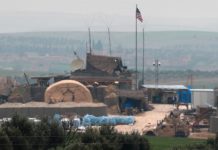In the middle of an office park near the Miami International Airport are 18 storage units with an outsize meaning for Venezuelans who have just arrived in South Florida. The storage facility can be hard to find amid the tangle of access roads, one-way streets, underpass tributaries and towering highways that make up the South Florida circulatory system. But Venezuelans, some of whom have arrived only days before, find it easily.
The migrants are part of a mass exodus of 6.8 million people who have fled the country, its spiraling crises and its pervasive misery. Some are drawn to the facility by word of mouth, because of its location in Doral, in Miami-Dade County; 35 percent of Doral’s population was born in Venezuela, according to the U.S. census.
Others find it on Instagram while still in Venezuela, said Patricia Andrade, founder of the organization Raíces Venezolanas, or Venezuelan Roots, which rents the units. Immigrants often arrive penniless and without possessions, clutching a plastic grocery bag of documents. But sites like Instagram and Google Maps provide directions to resources — including the Raíces storage units.
Last month, Gov. Ron DeSantis of Florida sent flights of Venezuelan migrants in Texas to Martha’s Vineyard in Massachusetts, a move that garnered attention and controversy. But that event provides a limited view of immigration patterns in the United States, and the communities they create. The Venezuelan population in Doral is one such community — a group that includes hundreds of families who took more traditional, if often perilous, journeys.
After making it to the border, many Venezuelans enter the United States at the crossing in Eagle Pass, Texas. That is where they claim political asylum, Ms. Andrade said.
If they successfully enter the United States, many Venezuelans head to Doral. Nicknamed “Doralzuela,” it is a hub of Venezuelan life in the United States. Most newly arriving migrants are drawn to the city because they have family and friends there, and they can begin their new lives on an air mattress in someone’s living room.
Four years ago, Pierina Rivas was one of those newly arrived Venezuelans starting over in Doral. Raíces helped set her up for this new chapter. She remembers getting sheets; towels; silverware; pots and pans; clothes for her daughter, Bianca; baby food for her newborn, José Thomas; car seats and a stroller.
Her family’s journey is a good example of the sometimes treacherous route that brings new members into these communities. Before fleeing to Florida in 2016, Ms. Rivas and her husband, José Chacin, had been living in Punta de Mata, a town in the northern part of Venezuela. They had never considered living in the United States.
“We always had a vision of a certain life,” Mr. Chacin said. “First you study, then you work, and then you have your own space,” added Ms. Rivas. (Mr. Chacin and Ms. Rivas spoke through an interpreter.)
They had that sort of life in Punta de Mata. Mr. Chacin worked at a tire distributor, and Ms. Rivas was a medical technologist. They owned their home. At the time, though, Venezuela was in turmoil. President Hugo Chávez had died in 2013, and his successor, Nicolás Maduro, was presiding over a country wracked with political, economic and social instability. Mr. Chacin and Ms. Rivas were longtime supporters of the opposition.
One day in late 2016, when she was pregnant with Bianca, Ms. Rivas was at her old elementary school, which had become a polling place for regional elections. “There was a guy wearing a shirt with Chávez’s face on it,” she recalled. “I went to the military guard and said, ‘You know, this guy can’t be in here supporting a candidate within the polling place. The law says he can’t do that.’”
The guard ignored Ms. Rivas, but the man wearing the Chávez T-shirt did not. Outside the polling place, he marched over to her. “You saw they didn’t do anything to me,” she recalled him saying. “There are a lot of us. We can do whatever we want.” She kept walking with a small group. Suddenly motorbikes surrounded them and were circling, their engines screaming. These were the Tupamaros, pro-government enforcers. Tears filled her eyes as she recalled, “I still have the sound in my head.”
One morning sometime later, Ms. Rivas, Mr. Chacin and his father were leaving their house when two men stepped out of the shadows and forced themselves inside. They asked, “Where is José Chacin?” Mr. Chacin assumed that since they were asking about him, they did not know what he looked like. Thinking fast, he told them that José Chacin was his brother, and that he was not at home. The two men took many things, including Mr. Chacin and Ms. Rivas’s cars, but left them unharmed.
These two incidents rattled Mr. Chacin and Ms. Rivas. They decided to move to Maturín, a nearby city. Bianca was a baby, and Ms. Rivas was pregnant with José Thomas. While in Maturín, however, they still attracted unwanted attention. Neighbors said people had stopped by, asking whether Ms. Rivas had moved in yet. Security cameras showed strangers looking at the house they had just moved into. Moving clearly had not worked. “I was a target,” Ms. Rivas said. “We had to go.”
They drove to the nearby city of Barcelona and boarded a flight to Miami, arriving on April 15, 2018. Because they left in a rush, they did not sell their assets in Venezuela, and arrived in the United States without a financial cushion. “It was a relief, but it was very sad to have to get on that airplane,” Ms. Rivas said. “It was scary to have to start all over with very little money.” During their first weeks in the country, Mr. Chacin and Ms. Rivas, still pregnant, slept in the same bed with Bianca — an air mattress in a friend’s apartment.
Raíces is trying to soften exactly these sorts of landings. Every Friday, volunteers open the storage units and hand out household items and clothes to anyone who shows up. “The mission of this is to be ready to help Venezuelans who are arriving and don’t have money,” Ms. Andrade said. “We try to have the minimum things to have quality of life.”
During a recent visit, one storage unit was filled with car seats — an expensive item that is crucial in car-dependent South Florida. Another had piles of dishes, utensils and other kitchen items. Other storage units were packed with children’s clothes and adult clothes, and one even had jewelry and perfumes. Many Venezuelans take jobs in construction or gardening, or at moving companies or carwashes, said Ms. Andrade, so durable clothing items such as jeans are in such high demand at Raíces that they are limited to one per person.
Her favorite storage unit is the one that holds toys. Children who make the arduous trip overland have spent weeks without toys, she said. “When they come here they get crazy,” she said.
This article is part of How I Got Here, a series about immigrants and migrants in America.
In addition to handing out essential items, Ms. Andrade and other volunteers interview migrants. (Raíces does not have offices; interviews are conducted at the storage units.) Almost all of the migrants say that they have made the eight-country trek from Venezuela to Colombia, then north through Panama, Costa Rica, Nicaragua, Honduras and Mexico. It is sometimes done solely on foot, but also by bus and boat. Many Venezuelans pass through the Darién Gap in Panama, described by the International Organization for Migration as “one of the world’s most dangerous refugee and migrant routes.” The route can be shortened if migrants have money, but the danger cannot be avoided.
(Ms. Andrade’s own immigration journey from Venezuela, 36 years ago, was less perilous, but she has not returned to the country since 2000. “Because of the crisis, I’m afraid to go,” she said. “You’re afraid because somebody would kill you if you have a good watch, or kill you because they want to kill you.”)
Four and a half years after their arrival, the Chacin-Rivas family is undeniably doing better. They have stable jobs. Ms. Rivas is working as a medical lab technician, similar work to what she had done in Venezuela. She does not have a customer-facing position, and her co-workers all speak Spanish. Unlike in many other immigrant communities in the country, learning English is not essential to making it in South Florida. Mr. Chacin is the supervisor of an assembly line that makes windows. Together the couple makes enough money to support themselves, as well as family members back in Venezuela, and to build a new life for their children. Bianca is now 5 and in kindergarten, and José Thomas is 4. They both love to draw and to go to parks, Ms. Rivas said.
On April 1, two weeks shy of their fourth anniversary of fleeing to the United States, the family moved into a house they bought in Homestead, a city in Miami-Dade County about 30 miles south of Doral. It was their first house in the United States, and they had worked furiously to afford it. Ms. Rivas cleaned houses and sold food. Mr. Chacin worked back-to-back jobs, leaving the house at 7 a.m. and returning at 11 p.m. His hands would fall asleep at night.
When asked about the day that she moved in, Ms. Rivas paused. A deep silence fell upon the house. “I felt strong,” she said at last.
Still, she has not forgotten the fragility of those early days, or the people like Ms. Andrade who helped the family get on their feet. Sitting in her new home, she pointed to coffee cups on her table. They came from Raíces, she said, and they remind her of those first months in the United States, when they had very little. “I keep them because they’re special,” she said.
Despite the relative permanence of homeownership, the family’s future in the United States is uncertain. Over four years into their migration journey, they are still waiting for an initial asylum interview. There is always the chance their application will be rejected and they will have to start over again somewhere else. But for the moment, they have found again their “vision of a certain life” — a family of four in a home of their own.
Nick Madigan contributed reporting.
Source : Nytimes













